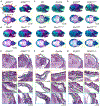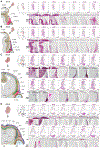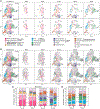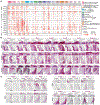Single-cell atlas of craniogenesis uncovers SOXC-dependent, highly proliferative, and myofibroblast-like osteodermal progenitors
- PMID: 35830813
- PMCID: PMC9595211
- DOI: 10.1016/j.celrep.2022.111045
Single-cell atlas of craniogenesis uncovers SOXC-dependent, highly proliferative, and myofibroblast-like osteodermal progenitors
Abstract
The mammalian skull vault is essential to shape the head and protect the brain, but the cellular and molecular events underlying its development remain incompletely understood. Single-cell transcriptomic profiling from early to late mouse embryonic stages provides a detailed atlas of cranial lineages. It distinguishes various populations of progenitors and reveals a high expression of SOXC genes (encoding the SOX4, SOX11, and SOX12 transcription factors) early in development in actively proliferating and myofibroblast-like osteodermal progenitors. SOXC inactivation in these cells causes severe skull and skin underdevelopment due to the limited expansion of cell populations before and upon lineage commitment. SOXC genes enhance the expression of gene signatures conferring dynamic cellular and molecular properties, including actin cytoskeleton assembly, chromatin remodeling, and signaling pathway induction and responsiveness. These findings shed light onto craniogenic mechanisms and SOXC functions and suggest that similar mechanisms could decisively control many developmental, adult, pathological, and regenerative processes.
Keywords: CP: Developmental biology; SOX11; SOX4; SOXC; craniogenesis; cytoskeleton; dermogenesis; intramembranous ossification; myofibroblast; osteogenesis; progenitor cell; skeletogenesis; skin; skull; suture; transcriptomics.
Copyright © 2022 The Author(s). Published by Elsevier Inc. All rights reserved.
Conflict of interest statement
Declaration of interests The authors declare no competing interests.
Figures







Similar articles
-
SOXC are critical regulators of adult bone mass.Nat Commun. 2024 Apr 5;15(1):2956. doi: 10.1038/s41467-024-47413-2. Nat Commun. 2024. PMID: 38580651 Free PMC article.
-
Organogenesis relies on SoxC transcription factors for the survival of neural and mesenchymal progenitors.Nat Commun. 2010 Apr 12;1(1):9. doi: 10.1038/ncomms1008. Nat Commun. 2010. PMID: 20596238 Free PMC article.
-
SOXC Transcription Factors Induce Cartilage Growth Plate Formation in Mouse Embryos by Promoting Noncanonical WNT Signaling.J Bone Miner Res. 2015 Sep;30(9):1560-71. doi: 10.1002/jbmr.2504. Epub 2015 May 21. J Bone Miner Res. 2015. PMID: 25761772 Free PMC article.
-
Regulatory roles for SOX11 in development, stem cells and cancer.Semin Cancer Biol. 2020 Dec;67(Pt 1):3-11. doi: 10.1016/j.semcancer.2020.06.015. Epub 2020 Jun 20. Semin Cancer Biol. 2020. PMID: 32574812 Review.
-
Critical roles for SoxC transcription factors in development and cancer.Int J Biochem Cell Biol. 2010 Mar;42(3):425-8. doi: 10.1016/j.biocel.2009.07.018. Epub 2009 Aug 3. Int J Biochem Cell Biol. 2010. PMID: 19651233 Free PMC article. Review.
Cited by
-
SOXC are critical regulators of adult bone mass.Nat Commun. 2024 Apr 5;15(1):2956. doi: 10.1038/s41467-024-47413-2. Nat Commun. 2024. PMID: 38580651 Free PMC article.
-
Reactivation of embryonic genetic programs in tissue regeneration and disease.Nat Genet. 2023 Nov;55(11):1792-1806. doi: 10.1038/s41588-023-01526-4. Epub 2023 Oct 30. Nat Genet. 2023. PMID: 37904052 Review.
-
Trajectory-centric framework TrajAtlas reveals multi-scale differentiation heterogeneity among cells, genes, and gene modules in osteogenesis.PLoS Genet. 2024 Oct 22;20(10):e1011319. doi: 10.1371/journal.pgen.1011319. eCollection 2024 Oct. PLoS Genet. 2024. PMID: 39436962 Free PMC article.
-
Lamellipodia-Mediated Osteoblast Haptotaxis Guided by Fibronectin Ligand Concentrations on a Multiplex Chip.Small. 2024 Dec;20(49):e2401717. doi: 10.1002/smll.202401717. Epub 2024 Sep 17. Small. 2024. PMID: 39286887 Free PMC article.
-
Identification of a novel de novo mutation in SOX4 for syndromic tooth agenesis.Clin Oral Investig. 2024 Apr 30;28(5):287. doi: 10.1007/s00784-024-05659-6. Clin Oral Investig. 2024. PMID: 38684576
References
Publication types
MeSH terms
Substances
Grants and funding
LinkOut - more resources
Full Text Sources
Molecular Biology Databases
Miscellaneous

